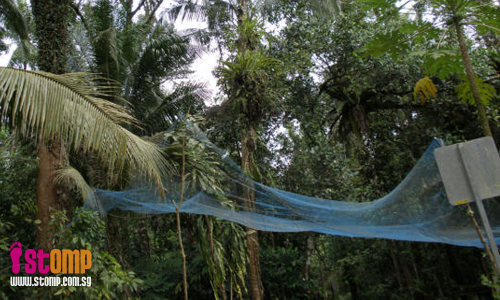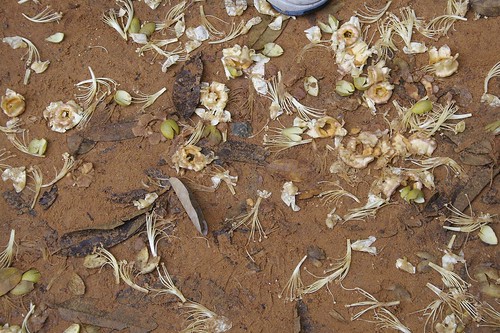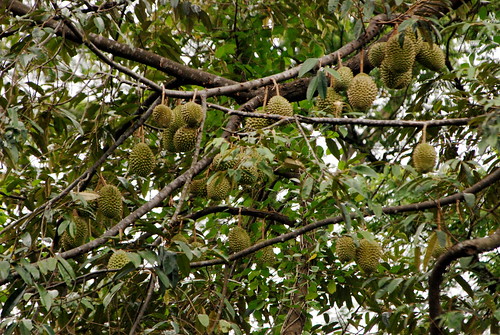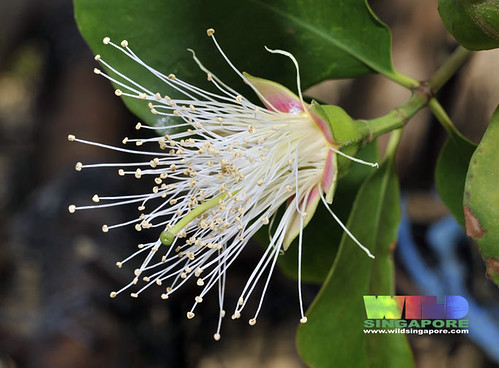
STOMPer Durian Lover was cycling at Pulau Ubin when he came across this ingenious way of catching falling durians.
In an email to STOMP today (June 4), the STOMPer says:
"These two pictures of a blue net were taken near a zinc house at Pulau Ubin.
"As I was cycling on the road, I saw the word 'SLOW' and reduced my speed as there was a bend in the road. I also noticed a blue net over my head, and all around me were coconut, papaya, star fruit and durian trees.
"The net was just below a durian tree laden with juicy fruits ready for picking. It then dawned upon me that the owner had put up the net for a purpose. He set up the net because either he was afraid that falling durians might injure cyclists and passersby, or he did not want passers-by to steal his durians, or perhaps he wanted to harvest the durians for himself without suffering any losses.
"Anyway he had an ingenious idea of putting up a net to catch his falling durians. If NParks had owned this piece of land, it would have put up a big notice with the words 'BEWARE OF FALLING DURIANS', like what has been done at Bukit Batok Nature Park."

Durian season has arrived on Pulau Ubin once again. When I was out guiding my colleagues around the Chek Jawa Boardwalk earlier today, many of them were excited to spot the fruit hanging from the branches. A couple of them even went to buy durian from one of the stalls in Ubin town.

Warning sign, Bukit Batok Nature Park;
(Photo by shimmertje)
There are actually 30 known species of durian in the genus Durio, with 9 species known to produce edible fruit. The species most commonly cultivated for food here in Southeast Asia is Durio zibethinus, although other species are highly prized in certain countries.
Not many people are aware of the fact that durian is pollinated by bats; as far as we know, the most important pollinator of Durio zibethinus flowers is the cave nectar bat (Eonycteris spelaea).

Cave nectar bat;
(Photo by kwokwai76)
Other species of bat known to visit durian flowers for nectar, and which may also contribute to pollination, include the greater long-tongued nectar bat (Macroglossus sobrinus), lesser long-tongued nectar bat (Macroglossus minimus), lesser dog-faced fruit bat (Cynopterus brachyotis), and even the Malayan flying fox (Pteropus vampyrus). Some insects, such as bees and moths, may also play some role in pollination, while in Sarawak, a study revealed that 2 other species of durian, Durio grandiflorus and Durio oblongus, are pollinated by spiderhunters, while a third species, Durio kutejensis, was pollinated by birds, bees, and bats.
Yumoto, T. 2000. Bird-pollination of three Durio species (Bombacaceae) in a tropical rainforest in Sarawak, Malaysia. American Journal of Botany, 87(8), 1181–1188.
Durian flowers begin to bloom in the mid-afternoon, but do not release pollen until about 7pm in the evening. They give off a strong scent, and also produce large amounts of nectar.

Durian flowers, Cairns;
(Photo by emblatame (Ron))
By morning, most of the flower has dropped off, leaving behind the pistil, or the female parts of the flower.

Fallen durian flowers, Pulau Ubin;
(Photo by November)
Other commercially important plant species in the region that are pollinated by bats include banana (Musa spp.), the bean known as petai (Parkia speciosa), the midnight horror or Indian trumpet tree (Oroxylum indicum), and even coconut (Cocos nucifera).
Bats, Plants and People is an excellent website that discusses the interesting relationships between bats and various species of plants that depend on these flying mammals for pollination and seed dispersal.

Cave nectar bat feeding from banana flower, Portsdown Road;
(Photo from Ecology Asia)
In some parts of Southeast Asia, mangrove forests may play a key role in durian propagation. But durian trees are intolerant of salt and generally grow inland. What then, is this connection with mangroves all about?

Durians, Southern Ridges;
(Photo by galigo)
It's common knowledge that durian is a seasonal fruit, flowering once or at most twice a year. For many of the bat species that pollinate durian flowers, it is essential that there are other sources of nectar and pollen to sustain them during the rest of the year, when the durian trees are not in bloom.
This is where the mangrove forests come in. Here in Southeast Asia, various species of the genus Sonneratia are a common feature of mangrove forests.

Perepat (Sonneratia alba), Pulau Semakau;
(Photo by Ria)
Perepat is a relatively common species in Singapore mangroves. 2 other Sonneratia species known to occur in Singapore are berembang (Sonneratia caseolaris) and gedabu (Sonneratia ovata); both species are considered to be locally endangered, and are highly restricted in distribution.

Flower of perepat, Pulau Semakau;
(Photo by Ria)
Like durian flowers, Sonneratia flowers are pollinated by bats, in particular the lesser long-tongued nectar bat and cave nectar bat.

Lesser long-tongued nectar bat, Philippines;
(Photo by Arddu)
The lesser long-tongued nectar bat is widespread throughout Southeast Asia, and can be found all the way to New Guinea, Solomon Islands, and northern Australia. In Peninsular Malaysia, the lesser long-tongued nectar bat is closely associated with Sonneratia, and appears to live almost exclusively in mangroves. One possible reason for such specialisation is due to the fact that in the mangroves of Peninsular Malaysia, berembang flowers are available as a food source all year round, while perepat and gedabu bear flowers for about three-quarters of the year, hence guaranteeing a regular food supply for this nectarivorous bat.

Cave nectar bat;
(Photo by Phil Myers)
The cave nectar bat, on the other hand, roosts inland, far from the coast. One notable roost can be found in the Batu Caves, north of Kuala Lumpur, and at least 38 kilometres away from the nearest mangroves. Yet analysis of pollen in the guano of these bats indicate that they do feed from Sonneratia flowers, which means that the bats may fly a considerable distance on their nightly foraging trips.
Remember that the cave nectar bat is believed to be the most important pollinator of durian flowers. Hence Sonneratia trees may play a crucial role in certain areas in serving as a stopgap, helping to support bat populations during the rest of the year when durian trees are not flowering. If the mangroves were in any way negatively affected and the Sonneratia trees were removed, it is possible that the bats may have to fly elsewhere in search of food, which will then have an impact on the pollination of durians, with consequences for the success of the durian crop.
In ecology, it is essential to remember that habitats and ecosystems do not exist in isolation; species can and do move between habitats, and changes in trophic relationships within a single habitat can have trickle-down impacts in other nearby biotopes. While implying that destruction of mangrove habitats can lead to a decline in durian harvest may be overly simplistic, it is one interesting way in which ordinary Singaporeans can get a glimpse of the myriad ways in which the Earth's species interact with one another.